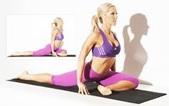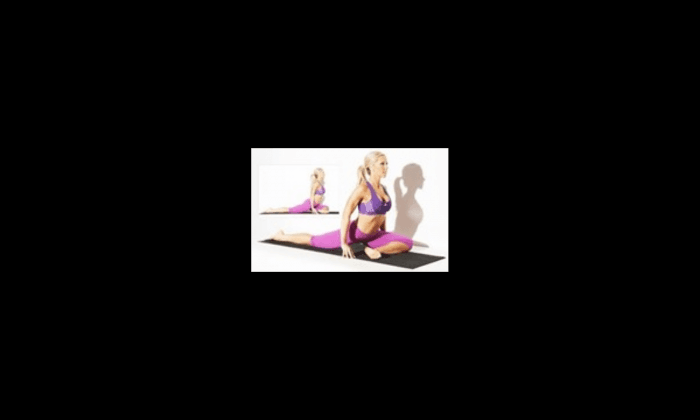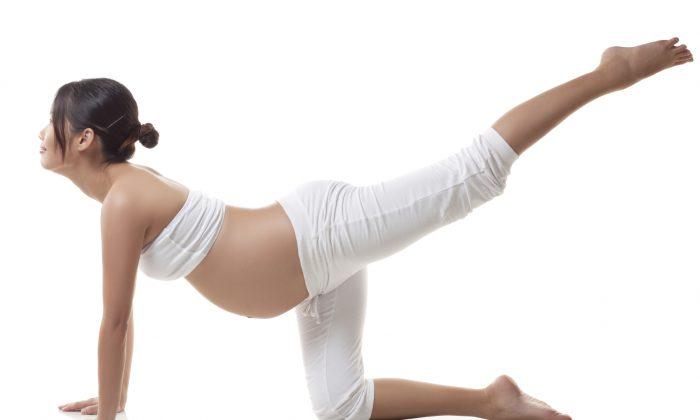During the holidays, the added stress can cause our cortisol levels to elevate. Cortisol is a hormone in the body that is important for the maintenance of blood pressure. It also stimulates insulin release to maintain healthy blood sugar levels, and stimulates fat and carbohydrate metabolism to provide fast energy for the body.
It is normal for cortisol levels to fluctuate during the day, but stress can cause them to remain high. When this happens, our bodies remain in “fight or flight” mode and resist weight loss by holding on to fat, particularly in the abdomen, where there are more cortisol receptors.
Yoga is a great way to combat stress and prevent weight gain all year round. Below is an easy to follow set of restorative yoga postures that can help calm the mind and keep cortisol levels under control this holiday season.
Be sure to speak to your doctor before starting a new exercise routine.
Viparita Karani

Also known as the “Legs up the Wall” pose, this is a restorative, relaxing, and gentle inversion that is therapeutic for arthritis, headaches, high blood pressure, low blood pressure, and insomnia. It relieves tired or cramped feet and legs and provides your hamstrings with a gentle stretch that can ease lower back pain.
1. Start sitting with one side of your body against the wall.
2. Lie down on the other side and roll on to your back, so that your sits bones are against the wall and your legs can extend overhead against the wall. Keep your arms down by the sides with palms up.
Tips:
• To stretch your inner thighs and groin muscles, make a “V” shape with your legs by letting your feet fall out to the sides.
• When rising from the position, push the bottoms of your feet into the wall. Gently roll to one side and stay there for a few breaths before returning to the upright position.
This posture is not recommended during menstruation or pregnancy, or if you have glaucoma or high blood pressure.
Marjaryasana and Bitilasana

Together, the “Cat” (Marjaryasana) and “Cow” (Bitilasana) poses stimulate the digestive tract, massage the belly, and stimulate the kidneys and adrenal glands. Using the breath to flow between the two postures helps to warm up the body, while also improving coordination.
1. Start on all fours, with wrists directly under the shoulders and knees under the hips. The spine should be long and neutral.
2. Round the spine sequentially from the tailbone to the head on the inhale to
come into the “Cat” pose. Then lengthen through the starting position and arch the upper mid-back on the exhale to come into the “Cow” position.
3. Continue to move through the two postures with regulated breath.
Tips:
• Make sure to keep the abdominals supported to protect the lower spine.
• Keep the neck long in the “Cow” pose, so the head becomes an extension of the spine.
These postures are not recommended if you have neck or lower back problems.
Eka Pada Rajakapotasana

Also known as the “Pigeon” pose, this move opens the hip flexor muscles called psoas and rectus femoris, as well as the muscles of the groin of the back leg. It also simultaneously opens the front hip muscles known as gluteus medius and gluteus minimus. As a result, this posture may help relieve sciatic nerve tension and ease chronic low back pain.
1. Starting on hands and knees, bring your right knee forward to the floor just behind your right hand with an outwardly rotated thigh. The more the front foot is in line with the front knee, the more intense the stretch.
2. Extend your left leg back behind you to place the shin on the floor, while keeping the hips square to the front.
3. While keeping the weight evenly distributed on the hands and legs, slowly lower the hips to the floor to deepen the stretch.
Tips:
• Tuck the toes of the back foot under to enable a more supported stretch for the hip flexors of the back leg.
• Lift the chest to the sky to open the front body and then lower the body diagonally over the
front knee to deepen the stretch of the front hip.
This posture is not recommended if you have knee, groin, meniscus, ligament, or sacroiliac joint injury.
Matsyasana

The “Supported Fish” (Matsyasana) pose opens the pectoralis muscles of your chest, the intercostal muscles between your ribs, and the upper portion of the psoas muscles in your hips. This pose opens the heart and throat chakras and can help improve your posture and the quality of your breath.
1. Lie down and place a bolster along your mid to upper back to keep your neck long and comfortable. You can place your head on the bolster if the arched position is too extreme. If you do not own a bolster, you can use a rolled up towel or yoga blanket, a foam roller, or two yoga blocks placed next to one another.
2. Place your arms out to the sides and legs straight. Do not press into your head. Maintain engaged legs by pressing your thighs down firmly on the floor.
Tips:
• If you have low blood pressure, press your arms on the floor to slowly rise from the pose. Roll on to one side and lie quietly for a few breaths before moving to avoid dizziness.
• If you have low back problems, keep your knees bent with feet flat on the floor or use a bolster along your entire spine to decrease the arch.
• If you have neck problems, use a bolster along the entire spine so the neck is supported.
This posture is not recommended if you have glaucoma or uncontrolled high blood pressure.
Ardha Matsyendrasana

This deep twist, also known as “Half Lord of the Fishes,” energizes the spine to relieve fatigue and helps to stimulate the liver and kidneys to promote digestion.
1. Sit on the floor with your knees bent. Then slide your left foot under your right leg to the outside of your right hip, relaxing the left leg on the floor.
2. Step the right foot further over the left leg and place it on the floor outside your left hip. The right knee should point directly to the ceiling.
3. Lengthen the spine and twist toward the right, placing the left elbow on the outside of the right knee to deepen the twist. You can use your left hand as a kickstand, with the fingertips on the floor next to the right hip. Continue to lengthen the spine on the inhale and deepen the twist on the exhale.
Tips:
• Imagine the ribs rotating on the spine to deepen the twist, rather than concentrating the twist in
the lower back.
• Press down into the hand that is on the floor to help lengthen the spine.
Ashley Whitson is an ACE-certified personal trainer, Pilates certified instructor, pre/postnatal exercise specialist, Functional Movement Systems professional, Neurokinetic Therapy practitioner, and professional dancer in New York. For more information, see AshleyWhitsonPersonalTrainernyc.com.




Friends Read Free